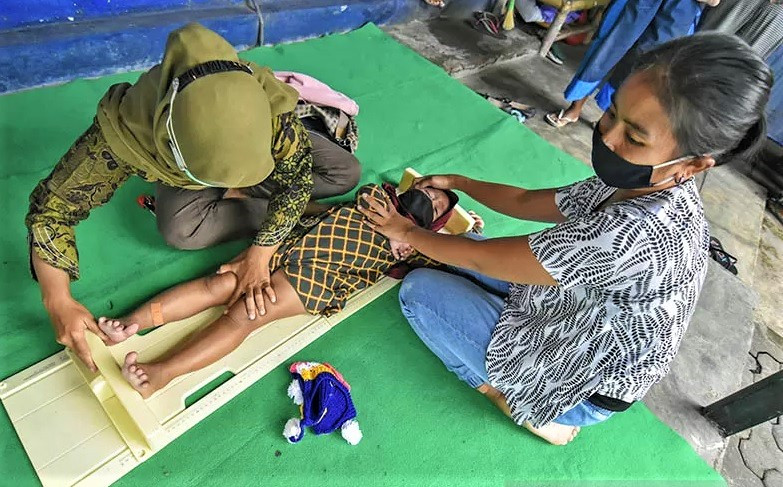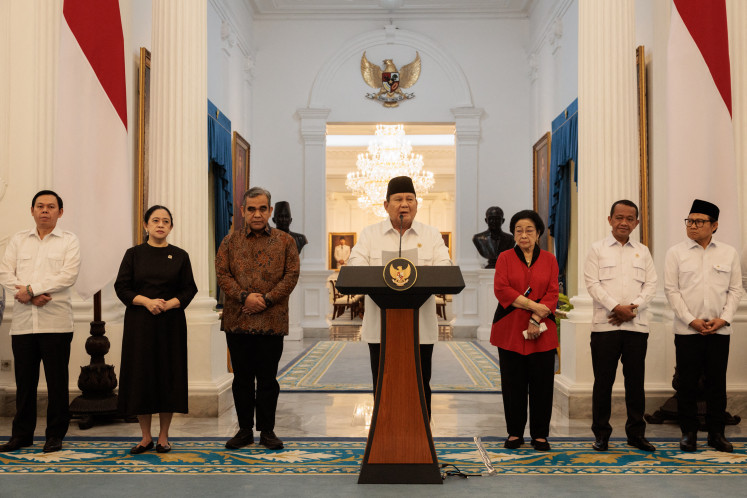Popular Reads
Top Results
Can't find what you're looking for?
View all search resultsPopular Reads
Top Results
Can't find what you're looking for?
View all search resultsLong fight against stunting
The Health Ministry’s Indonesian Nutrition Status Study (SSGI) in 2021 found that with a 24.4 percent stunting prevalence, one in four Indonesian children under five was stunted.
Change text size
Gift Premium Articles
to Anyone
 Aiming high: Health community center (Puskesmas) volunteers measure the height of a child in Kutilang, Ampenan subdistrict, West Nusa Tenggara, on April 8, 2021. Indonesia has reduced the nationwide rate of child stunting from 31 percent in 2018 to 24 percent in 2021, with the aim of further dropping the figure to below 14 percent by 2024. (Antara/Ahmad Subaidi)
Aiming high: Health community center (Puskesmas) volunteers measure the height of a child in Kutilang, Ampenan subdistrict, West Nusa Tenggara, on April 8, 2021. Indonesia has reduced the nationwide rate of child stunting from 31 percent in 2018 to 24 percent in 2021, with the aim of further dropping the figure to below 14 percent by 2024. (Antara/Ahmad Subaidi)
P
resident Joko “Jokowi” Widodo last year set a lofty goal of significantly reducing the prevalence of stunting from 24.4 to 14 percent of children by the time he completes his second term in 2024. To that end, the President last week said that stunting intervention would be one of the government’s spending priorities for 2023.
While the government has yet to reveal exactly how much it is going to spend on the effort and what specific activities the money will go toward, it remains to be seen whether the government will really go the extra mile for the target.
Stunting, low height for one’s age, is what happens to a human child suffering from years of malnutrition. Needless to say, the ramifications of stunting last a lifetime.
In 2013, the Health Ministry's Basic Health Survey estimated that 9 million children under the age of five were stunted as Indonesia faced high levels of malnutrition. In 2020, at the onset of the COVID-19 pandemic, the United Nations agency for children UNICEF estimated that more than 2 million children suffered from severe wasting, and that stunting occurred in more than 7 million children under five.
In its most recent study on the issue, the Health Ministry’s Indonesian Nutrition Status Study (SSGI) in 2021 found that with the prevalence of stunting at 24.4 percent, one in four Indonesian children under five was stunted.
In his speech to kickstart his second term in 2019, Jokowi reiterated his vision for Indonesia to be a developed country by 2045 and the world’s fifth-largest economy. By 2045, Indonesia’s population is expected to exceed 300 million, while its per capita income is hoped to reach US$23,000.
The President stipulated during the early days of his administration that human capital was one of the prioritized sectors needed to achieve the vision’s goals.
Leaving stunting in children unaddressed would be a major setback to these dreams.
In a decree issued last year on the acceleration of stunting reduction, Jokowi aims to slash the rate by 10.4 percent in less than 2.5 years. This target could very well be overambitious, considering that the country had only managed to cut down the rate by about 2 percent each year from 2013 to 2021, although in reality the rate only declined by an average of 1.6 percent annually over the past three years.
To reach his goals, Jokowi's campaign against stunting should have been part of his Nawacita (nine key programs) when he assumed power in 2014. Better late than never, nevertheless.
To his credit, he has shown a level of seriousness and leadership in this issue, knowing that it would define Indonesia’s future.
Scholars have suggested a strong link between the support or political commitment of the government and the incidences of stunting in children in a country. The presidential or prime minister’s office, for example, has been a key driver in accelerating the drop in stunting in Brazil, Peru and Ethiopia.
Unlike Jokowi’s other projects and programs that he launched to leave a lasting legacy when he steps down, stunting reduction is among those that we would like him to succeed in.
Investing in programs to curb stunting in children will return in quality generations that Indonesia needs the most to reap its demographic bonus.










